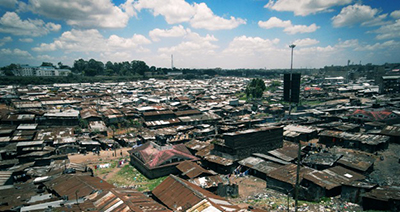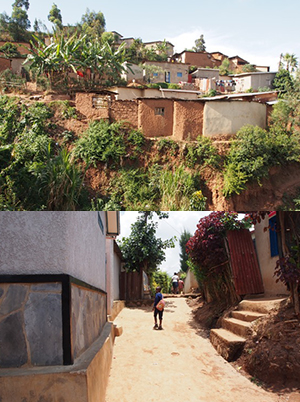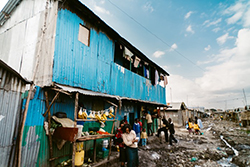
ここからコンテンツです。

Considering the appeal of cities through informal settlements
Haruka Ono

Urban planning specialist Dr. Haruka Ono, lecturer in Architecture and Civil Engineering at Toyohashi University of Technology, specializes in the study of informal settlements, the kind of sprawling residential areas found outside of cities in places such as Africa and India. Informal settlements are organically occurring urban developments that exist beyond public frameworks such as urban planning laws and land systems. In particular, the crowded informal settlements in Africa and India are an intake hub for rapidly growing urban populations. This contributes to the creation of slums. On the other hand, due to unique rules and residential practices, some aspects of these settlements can actually be more appealing than existing intentionally-built cities. Dr. Ono is continuing fieldwork with students to discover the main factors of their appeal.
Interview and report by Madoka Tainaka
From backpacking to fieldwork
As an elementary school student, Dr. Ono was interested in the issues of global conflict and poverty, and she dreamed of finding a job where she could help people around the world.
Determined to see what was actually going on around the world with her own eyes, she took time off from university and spent two to three years backpacking through Asia, the Middle East, Africa, and South America. Among these, the region that impacted her most was Africa.
"I was bewildered by the cultural differences in the way that Africans and Asians managed personal distance compared with people in Asia. As a result, I could not communicate well. Something felt cold,” says Dr. Ono. “What shocked me was the way that people were living in modern cities, which were built by European nations in the colonial era. Being built over a century ago, they were deteriorating and not very lively. I think this is partially due to the local religions and culture being oppressed under colonial rule. This was the first time I began to think about the true identity of Africa," she says.

Once Dr. Ono eventually began working as a researcher in urban planning, she focused her attention on the informal settlements sprawling around the fringes of modernized cities. These illegally inhabited and dense slum areas developed without any planning.
"Historically, informal settlements have been targeted as being in need of improvement. However, after going into them, I found them to be quite attractive spaces, with close connections between people and a uniquely African identity. In Japan, development has progressed through urban planning, but I don’t find the new cities to be very appealing. I therefore investigated how the residents of informal settlements thought about creating their space and rules, and I considered how to apply my findings to future urban planning," she says.
Moderate government intervention and land ownership are key
In the Rwandan capital of Kigali, 79% of the population lives in informal settlements. While the government works to resettle and improve the area, residents living in the informal settlements are putting up their own capital and working to improve their living environment.

“The key is moderate government intervention,” says Dr. Ono. “Residents are granted a certain amount of land ownership even on illegally acquired land, which they can then use as collateral for loans. In addition, ownership creates an attachment to the land, which helps encourage behavior to improve and retain its value as an asset. As a result, residents are working together, paving brick roads in front of their homes, and improving drainage ditches to protect buildings from severe seasonal rain. This is possible due to government budgets that residents can freely determine how to use as well as a unique relationship of trust where individual capital is concentrated in community leaders,” she says.
The success of these developments is a tribute to the spirit of the Rwandan people. In spite of having to overcome the tragic 1994 genocide, the current prime minister’s bold leadership has served as a foundation for the nation’s future. In this vision, Rwanda aims to become the Singapore of Africa, with a powerful government pushing cutting edge environmental initiatives and taking proactive advantage of IT.

On the other hand, in Nairobi, the capital city of another African nation, Kenya, things seem quite different. In Nairobi’s informal settlements, residents on illegally acquired land have built simple two-story homes from galvanized iron and are operating thriving businesses by renting out the rooms. Since costs can be recouped within two to three years and no taxes are paid, the operators can become wealthy.
"Ultimately, those who can acquire land become rich while the actual residents are impoverished. With profit as the only goal, these cities lack any appeal,” says Dr. Ono. “In considering these differences, I have developed an interest in the way land ownership works in different places. While the balance between land ownership and use varies by country, land ownership rights are extremely strong in Japan. Comparatively, in informal settlements, the recognition of land ownership is loose," says Dr. Ono.

In many cases in Africa, even without an official registry, land ownership is secured through some sort of authority. A neighborhood association head, elder, politician, or another local leader will write up a simple document to recognize ownership. When an issue arises, the leaders mediate.
"Some people are given approval from up to five regional leaders. In other words, an individual’s property rights are common knowledge shared in the community," says Dr. Ono. "This loose ownership structure fosters a sense of mutual support in the community and is thought to make possible the effective use of public space such as squares and help secure traffic at community boundaries.

“Of course, at the same time, there are so many different configurations among informal settlements that it is difficult to determine any universal factors that can make a city more appealing. While these cities are not equipped with hard infrastructure like sewerage and public transportation, they have become new urban testing grounds using IT and should provide hints for strategies to create cities in the future,” says Ono.
Applying the knowledge and experience gained through this research to develop toyohashi
Currently, while conducting concurrent fieldwork overseas, Dr. Ono is a member of the Toyohashi “Machinaka” Conference, which works to manage the local area in front of Toyohashi Station. Serving as an expert, Dr. Ono is involved with developing a vision alongside students and young employees at local businesses.

"Toyohashi is at risk of suffering significant damage from a large earthquake along the Nankai Trough. Advanced reconstruction initiatives are underway to address this. We have created an advanced reconstruction plan and secured required land for construction and temporary housing. Deliberations are moving forward on whether to rebuild on land damaged by a tsunami or to relocate, before such a disaster strikes," Dr. Ono says.
With the ongoing demands of day-to-day work, considering post-earthquake situations ahead of time is difficult. As such, Dr. Ono says it is crucial for universities to objectively show what can happen and then propose necessary measures based on scientific knowledge. That is why, when working in the community, she is committed to maintaining a neutral position as a university member.

The fieldwork technique of 'participant observation' has been helpful in this regard. "Participant observation is a study method used in cultural anthropology. While living as a member of the society, you allow your activities to be understood by the locals, and upon receiving clear consent regarding the purpose of your study, you observe and listen to the residents. In order to carry this out properly, maintaining appropriate personal distance is crucial. The most important thing is showing respect to the subjects as human beings before being a researcher. Without getting too involved, I am careful never to lose sight of my position as a researcher and so to maintain an objective perspective."
With her unique research results and methods, we hope Dr. Ono can bring further innovations to the somewhat uniform and unappealing new urban environments in Japan.
Reference
https://onounit2018.wixsite.com/iup-tut
https://www.biz-lixil.com/column/urban_development/pk_serial007/ (Japanese only)
https://www.biz-lixil.com/column/urban_development/pk_serial008/ (Japanese only)
Reporter's Note
Dr. Ono has visited some 90 countries, starting first with an overseas homestay experience as a middle school student, followed by backpacking during university and finally her extensive fieldwork.
"Of course, I want to help society through my research, but my foremost interest is coming into contact with the unknown. That is why I cannot stop conducting fieldwork. I actually have yet to visit most European and North American countries. In the future, I hope to study European and American cities as well," she says in regard to her forthcoming prospects.
This interview took place at the end of February via web conference, at the outset of the spread of the coronavirus in Japan. At that time, there was little understanding of the severity of the situation that was about to unfold. We hope the situation will be resolved as soon as possible and pray for the day when we can freely travel across the world once again.
インフォーマル市街地から都市の魅力を考える
都市計画を専門とする小野悠講師が研究対象としているのは、アフリカやインドなどの都市に広がる、「インフォーマル市街地」である。インフォーマル市街地とは、都市計画法や土地制度などのオフィシャルな枠組みの外側で、自然発生的に形成された都市のこと。とくにアフリカ諸国やインドでは、インフォーマル市街地が、急増する都市人口の受け皿として人々が集住し、スラム化の一因になっている。一方で、これらの街では住民主導の独自のルールや実践により、計画的に建設された既存の都市よりもむしろ魅力的な姿を見せる場合があるという。小野講師は、その魅力の要因を探るため、学生とともにフィールドワークを続けている。
バックパッカーを経てフィールドワークへ
小学生の頃から国際紛争や貧困問題に関心があり、世界を舞台に人の役に立つ仕事をしたいという夢を持っていた小野講師。現場を見て、自ら良し悪しを判断できる環境に身を置きたいと、大学を休学して、2〜3年ほどバックパッカーとして単身、アジアや中東、アフリカ、南米を旅して回った。そのなかでもっとも衝撃を受けたのがアフリカだったという。
「アジア人とは違う距離感に戸惑い、最初はコミュニケーションがうまく取れませんでした。何か冷たいと感じたんですね。なかでもショックだったのが、植民地時代にヨーロッパ諸国が築いた近代的な都市における人々の暮らしぶりです。建設から1世紀あまりを経て荒廃し、活気がない。植民地下で宗教や文化が断絶されたことの影響もあると思います。そこで初めて、アフリカらしさとは何か、と考えるようになりました」
やがて都市計画の研究者としての道を歩むなかで小野講師が目を向けたのが、近代化された都市の外側に広がる「インフォーマル市街地」だ。これは都市計画のおよばない都市の周辺に、いわば違法に住み着いた人たちによるスラム街で、劣悪な環境のなかに人々が密集して暮らしている。
「従来ならその環境改善が課題となってきたわけですが、そのなかに入っていくと、むしろインフォーマル市街地にこそ、人々のつながりやアフリカらしさがあり、魅力的な空間が形成されていることに気づきました。翻って、日本では都市計画を大前提に開発が進められてきましたが、新しい都市にはあまり魅力を感じません。そこで、インフォマール市街地に住む人たちがどういう視点で空間を形成し、ルールを形成しているのかを調べ、今後の都市計画に生かしていけたらと考えているのです」
行政の適度な介入と土地の所有がカギを握る
たとえばルワンダの首都キガリは、人口の79%がインフォマール市街地に住んでいる。政府が移転や環境改善を進める一方で、インフォマール市街地に住む住民たち自身が自己資金を出し合い、居住の改善を行っている。
「ポイントは行政の適度な介入です。違法に取得した土地であっても、住民に一定程度の土地の所有権を認めることで、土地を担保にローンを組むことができます。また、所有が土地への愛着を生み、資産価値を維持・向上させる行動へとつながっている。結果として、住民たちが協力し合い、家の前の道路をレンガで舗装したり、雨季の激しい雨から建物を守るために排水溝を整備したりしているのです。それが可能なのは、住民が自由に使途を決めることができる政府予算の存在に加え、コミュニティのリーダーを中心に自己資金を集める独自の信頼関係があるためです」
その背景には、ルワンダの人々の真面目な国民性もある。また、1994年に起こったジェノサイドの悲劇を乗り越え、現大統領による強大なリーダーシップのもと、アフリカのシンガポールをめざして、ITの積極的な活用や環境への先進的な取り組みを推進してきた政策の力も大きい。
一方、同じアフリカでも、ケニアの首都ナイロビでは様相がかなり異なる。ナイロビのインフォマール市街地では、違法に土地を取得した人がトタンでつくった簡素な2階建ての家を建て、部屋を貸し出すビジネスが盛んだ。2〜3年ほどで元手が回収できるうえ、税金も払わないので儲かるという。
「結局、土地を取得できるのは金持ちで、住んでいるのは貧困層の人々です。単に儲けを追求した都市は、けっして魅力的ではありません。その違いを考えるなかで関心を持っているのが、土地の所有のあり方です。土地の所有と利用のバランスは各国それぞれで、それこそ日本は土地の所有権が非常に強い。比べてインフォーマル市街地では、土地の所有権も承認のあり方もゆるやかです」と小野講師は言う。
アフリカでは、登記などの公的なものがなくても、なんらかの権威によって土地の所有が保証されている場合が多いという。自治会長や長老、政治家など、地域のリーダーに一筆書いてもらい、所有を認めてもらうのだ。何か問題が起こった際もリーダーが仲裁に入る。
「なかには5人くらいの地域のリーダーに承認してもらう人もいます。つまり、個人の権利が地域の共通意識として周知されているわけです。こうしたゆるやかな所有形態により、コミュニティの互助が醸成され、敷地境界の往来確保や広場などのパブリックスペースの有効活用が可能になっていると考えられます。
もちろん一口にインフォーマル市街地と言っても、その成り立ちも空間も実に多様で、そこから都市の魅力につながる普遍的な要素を見つけ出すことは難しい。ただこれらの都市は、上下水道や交通などのハードなインフラが整備されていないけれど、ITを活用した新しい都市の実験場にもなっていて、これからの都市のつくり方の一つのヒントになり得るのではないかと思っています」
研究で得た知見と経験を豊橋のまちづくりへ
一現在、小野講師は海外のフィールドワークと並行して、地元の豊橋駅前のエリアマネジメント活動を担う「豊橋まちなか会議」のメンバーとして、専門家の立場から、地元の企業の若手や学生などとともにビジョンづくりに携わっている。
「豊橋は南海トラフ巨大地震で大きな被害を受ける可能性があります。そこで取り組んでいるのが、事前復興です。復興計画を事前につくり、復興に必要な土地や仮設住宅の用地の確保、津波被害を受けた土地に再建するのか、あるいは移転するのかなどの議論を事前に進めようとしています」
日々の業務に追われるなかで、震災後のことを事前に考えるのは難しい。そうしたなかで、科学的知見に基づき、起こり得ることを客観的に示して、その後に必要な施策を提案できる大学の存在は重要だと小野講師は語る。だからこそ、地元へ働きかける際には、大学人としての中立的な立場を心がけているという。
そこで役立ったのが、フィールドワークで行っている「参与観察」という手法だ。
「参与観察とは文化人類学で用いられる調査技法で、社会の一員として生活しながら、自分のことを地域の人たちに知ってもらい、調査の目的を明確にしたうえで住民を観察、ヒアリングするものです。うまく進めるためには、距離感が重要です。もっとも大切なのは、研究者である前に、一人の人間として相手に敬意を示すこと。あまり入り込みすぎないように、いつでも自分の立ち位置に戻れるように、客観的な視点を忘れないようにしています」
ぜひ、ユニークな研究成果と手法を携えて、日本の画一的で魅力に乏しい新興都市のあり方に一石を投じてほしい。
(取材・文=田井中麻都佳)
取材後記
中学生の頃から経験してきた海外でのホームステイや大学時代のバックパッカー、フィールドワークを通じて、すでに訪れた国は約90カ国にのぼるという小野さん。
「もちろん、研究成果を社会に役立てたいという思いはありますが、それ以前に、未知のものに触れること自体が面白いんです。だからフィールドワークは止められない。じつはまだ、欧米諸国はほとんど訪れたことはありません。これからは欧米の都市も勉強しなければと思っています」と将来展望を語った。
今回の取材は、日本で新型コロナウイルスの感染拡大が始まった2月下旬にWeb会議システムを通じて行ったのだが、このときはまだ、これほどまでに世界の状況が悪化することは予測できなかった。1日も早く事態が収束し、世界各国を自由に行き来できる日が来ることを祈っています。
Researcher Profile

Dr. Haruka Ono
Dr. Haruka Ono received her M.S. and PhD degree in 2012 and 2016 respectively from University of Tokyo, Japan. She was project assistant professor in 2016 and project associate professor in 2017 at Ehime University. Since She started her career at Toyohashi University of Technology in 2017, had been involved in Urban and Regional Planning. She is currently a lecturer at the Department of Architecture and Civil Engineering, Toyohashi University of Technology.
Reporter Profile

Madoka Tainaka is a freelance editor, writer and interpreter. She graduated in Law from Chuo University, Japan. She served as a chief editor of "Nature Interface" magazine, a committee for the promotion of Information and Science Technology at MEXT (Ministry of Education, Culture, Sports, Science and Technology).
ここでコンテンツ終わりです。
